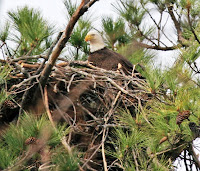 |
| Photo By John Bragg |
The bald eagle (Haliaeetus leucocephalus) is so named for its dynamic looks. Both the mature male and female have dark brown plumage with white feathers on their head, neck and tail, yellow feet and a large yellow beak. The term “bald” is derived from an older meaning of the word, "white headed".
Bald eagles are usually found near large bodies of water, so it is natural that their diet consists mainly of fish. However, they are opportunistic hunters and will feast on carrion when found. When hunting fish, the eagle swoops down over the water and grabs the fish with its talons. If the fish is too large for the eagle to carry there is a chance that the eagle may drown. Bald eagles can swim (a modified butterfly stroke), but they must reach land before they are able to fly again. This can put them at risk for hypothermia!
The bald eagle is the largest bird in North America. The female, which is slightly larger than the male, averages a body length of 36 inches and an impressive wingspan of between 79 and 90 inches. Eagles reach maturity between 4 and 5 years of age and usually mate for life. They generally lay between 2 and 3 eggs per year, although it is rare that all of the chicks will survive. Eagle nests are reused each year and new materials are added with each use. The largest eagle nest on record is in Florida and was measured to be 13 feet deep and 8 feet across.
 |
| Photo by John Bragg |
It is said the eagle was used as a national emblem because, at one of the first battles of the Revolution the noise of the struggle awoke the sleeping eagles on the heights and they flew from their nests and circled about over the heads of the fighting men, all the while giving vent to their raucous cries. "They are shrieking for Freedom," said the patriots.
Thus the eagle, full of the boundless spirit of freedom, living above the valleys, strong and powerful in his might, has become the national emblem of a country that offers freedom in word and thought and an opportunity for a full and free expansion into the boundless space of the future.
When Europeans first arrived to the North American continent bald eagles were common. But as the human population increased, the eagle population decreased. Between 1917 and 1953, more than 100,000 bald eagles were killed in Alaska by salmon fisherman who feared they were endangering the salmon population. In the 1930s people became more aware of the constantly decreasing eagle population and in 1940 the Bald Eagle Protection Act was passed. This prohibited people from the taking of, possession and commerce of such birds as the bald eagle and the golden eagle.
 |
| Photo by John Bragg |
In the 1960s and 70s many states placed the bald eagle on their endangered species list. In 1967 the bald eagle was officially declared an endangered species in all areas of the U.S. below the 40th parallel. This action predated The Endangered Species Act that President Richard Nixon signed into law in 1973. This was considered one of the most comprehensive and important wildlife conservation laws in the world. But by that time, the bald eagle population on the James River had been decimated.
In a testament to the species’ resiliency, in July 2007, decades after banning DDT, and passing laws to protect the bald eagle and their nests, the U.S. Fish and Wildlife Service changed their listing from “endangered” to “threatened.” The bald eagle is one of the few species that have come back from the endangered species list and today, a record number of 165 breeding pairs of bald eagles have been recorded on the James River.
Top 5 Places to spot a Bald Eagle
No comments:
Post a Comment